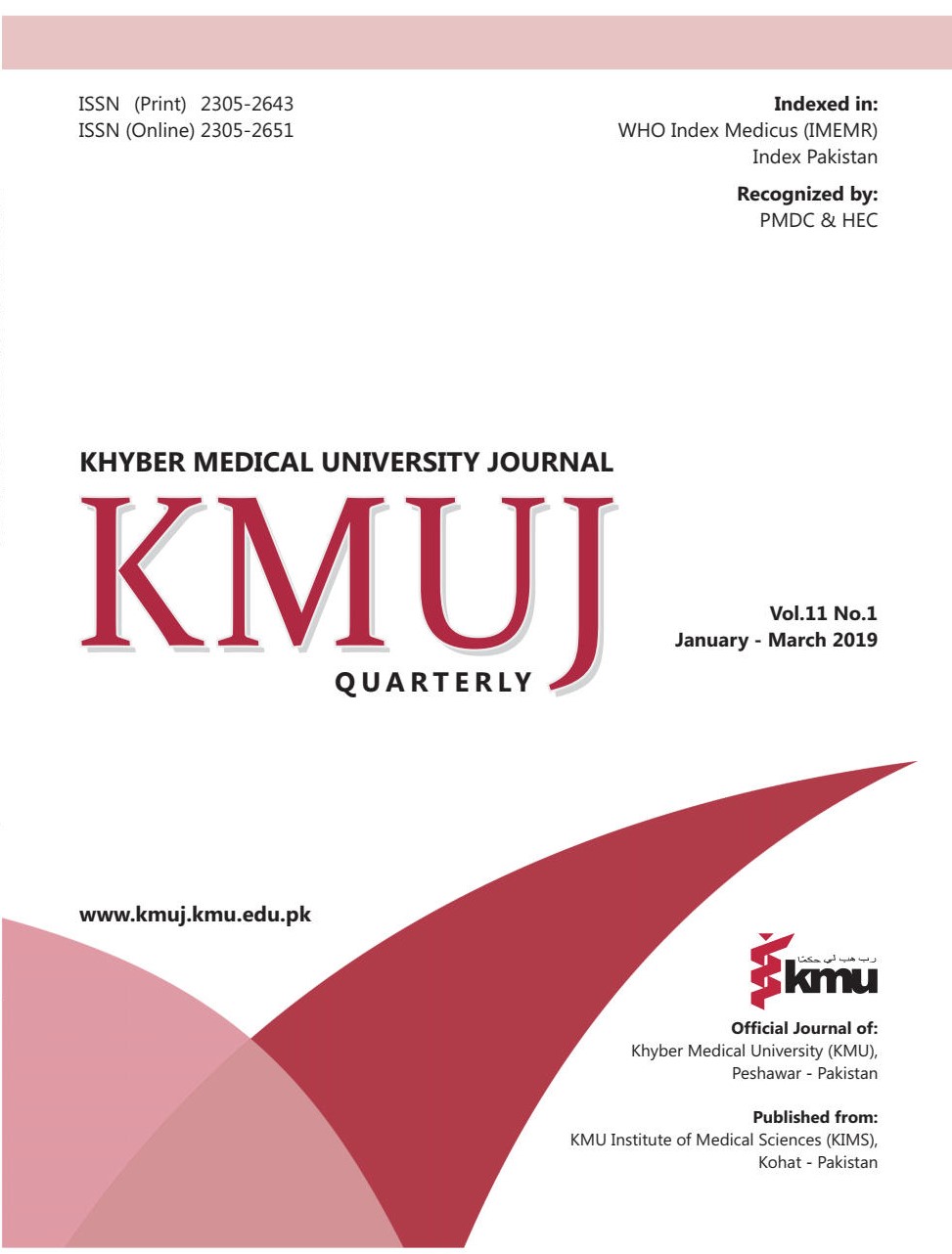CAUSES OF LOWER LIMB AMPUTATION IN PATIENTS REGISTERED AT PAKISTAN INSTITUTE OF PROSTHETIC AND ORTHOTIC SCIENCES PESHAWAR-PAKISTAN
Main Article Content
Abstract
OBJECTIVE: To find out the main causes of lower limb amputation (LLA) during the four years period at Pakistan Institute of Prosthetic and Orthotic Sciences (PIPOS) Rehabilitation Services Programme (PRSP) Peshawar, Khyber Pakhtunkhwa, Pakistan.
METHODS: This retrospective cross-sectional study evaluated four-year records of the registered LLA patients from PRSP Peshawar for assessment and evaluation from January 2010 to December 2013. The collected data was analyzed using Microsoft Excel, descriptive analysis like means, standard deviation, percentages, range etc, on the bases of age, gender and causes of amputation were calculated.
RESULTS: Out of 5820 patient with LLA registered during the study period, 5116 (87.9%) were males and 704 (12.1%) were females. Mean age of patients was 37±19 years and about 67.6% (n=3933) patients were ≤40 years of age. Overall, trans-tibial amputations were common (n=3582/5820; 61.6%), followed by trans-femoral amputation (n=1496; 25.7%). Generally, an increasing trend in frequency of patients with LLA was observed over four years. Major causes of LLA were trauma (61.9%), reconstructive surgeries (15.4%), various diseases (8.2%) and congenital (2.1%). In 12.4% cases, cause of LLA was not documented. Bomb blast injuries (21.6%) and road traffic accidents (14.6%) were main traumatic causes of LLA and diabetes mellitus (4.6%) was the commonest disease-related cause of LLA.
CONCLUSION: Majority of patients were males and were ≤40 years of age. Trans-tibial amputations were common. Trauma (mainly bomb blasts injuries and road traffic accidents), reconstructive surgeries and various diseases like diabetes are the leading causes of LLA in patients at PRSP, Peshawar Pakistan.
Article Details
Work published in KMUJ is licensed under a
Creative Commons Attribution 4.0 License
Authors are permitted and encouraged to post their work online (e.g., in institutional repositories or on their website) prior to and during the submission process, as it can lead to productive exchanges, as well as earlier and greater citation of published work.
(e.g., in institutional repositories or on their website) prior to and during the submission process, as it can lead to productive exchanges, as well as earlier and greater citation of published work.
References
REFERENCES:
Murdoch G, Wilson AB Jr, eds. Amputation: Surgical Practice and Patient Management. St Louis, Mo: Butterworth-Heinemann Medical; 1996. DOI: 10.1002/bjs.1800840360.
Eardley WG, Taylor DM, Parker P. Amputation and the assessment of limb viability: perceptions of two hundred and thirty two orthopaedic trainees. Ann R Coll Surg Engl 2010;92(5):411-6. DOI: 10.1308/003588410X12664192074973.
Higgins TF, Klatt JB, Beals TC. Lower Extremity Assessment Project (LEAP)--the best available evidence on limb-threatening lower extremity trauma. Orthop Clin North Am 2010;41(2):233-9. DOI: 10.1016/j.ocl.2009.12.006.
Esquenazi A, Yoo SK. Amputation Epidemiology and Assessment. American Academy of Physical Medicine and Rehabilitation. [Cited on: March 01, 2019]. Available from URL: https://now.aapmr.org/lower-limb-amputations-epidemiology-and-assessment/
Ziegler-Graham K, MacKenzie EJ, Ephraim PL, Travison TG, Brookmeyer R. Estimating the prevalence of limb loss in the United States: 2005 to 2050. Arch Phys Med Rehabil 2008;89(3):422-9. DOI: 10.1016/j.apmr.2007.11.005.
Masood J, Irfan A, Ghulam MK. Current Indications for major Lower Limb amputations at Civil Hospital Karachi. Pak J Surg 2008;24(4): 228-31.
Rathore FA, Ayaz SB, Mansoor SN, Qureshi AR, Fahim M. Demographics of Lower Limb Amputations in the Pakistan Military: A Single Center, Three-Year Prospective Survey. Cureus 2016 Apr 11;8(4):e566. DOI: 10.7759/cureus.566.
Omoke NI, Nwigwe CG. Limb Amputations in Abakaliki, South East Nigeria. African J Med Health Sci 2016;5(1):30-5. DOI: 10.4103/2384-5589.183890
Paudel B, Shrestha BK, Banskota AK. Two faces of major lower limb amputation. Kathmandu Univ Med J 2005;3(3):212-6.
Pooja GD, Sangeeta L. Prevalence and aetiology of amputation in Kolkata, India: A retrospective analysis. Hong Kong Physiother J 2013;31(1):36-40. DOI: 10.1016/j.hkpj.2012.12.002.
Rouhani A, Mohajerzadeh S. An Epidemiological and Etiological Report on Lower Extremity Amputation in Northwest of Iran. Arch Bone Jt Surg 2013;1(2):103-6.
Singh G, Pithawa AK, Ravindranath G. Study of Disabled Treated at Artificial Limb Centre. Med J Armed Forces India 2009 Jul; 65(3):232-4.
Maqsood M, Ali N, Bhat A, Bangroo FA, Dhanda MS, Singh R. Current trends of major lower limb amputations at a tertiary care centre of Jammu, India. Int J Med Sci Res Pract 2015 Jun 30;2(2):77-80.
Awais SM, Dar UZ, Saeed A. Amputations of limbs during the 2005 earthquake in Pakistan: a first-hand experience of the author. Int Orthop 2012 Nov;36(11):2323-6. DOI: 10.1007/s00264-012-1589-3.
Humail SM, Ilyas S, Baqai FU. Diabetic Foot: major cause of lower limb amputations. J Surg Pak 2004;9(4):19-21.
Salahuddin O, Azhar M, Imtiaz A, Latif M. A developing world experience with distal foot amputations for diabetic limb salvage. Diabet Foot Ankle 2013 Oct 21;4:22477. DOI: 10.3402/dfa.v4i0.22477.
Unnikrishnan EP, Rollands R, Parambil SM. Epidemiology of major limb amputations: a cross sectional study from a South Indian tertiary care hospital. Int Surg J 2017;4(5):1642-6. DOI: 10.18203/2349-2902.isj20171613.
